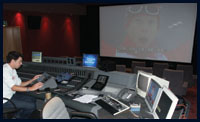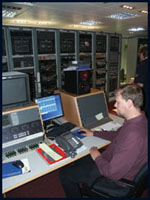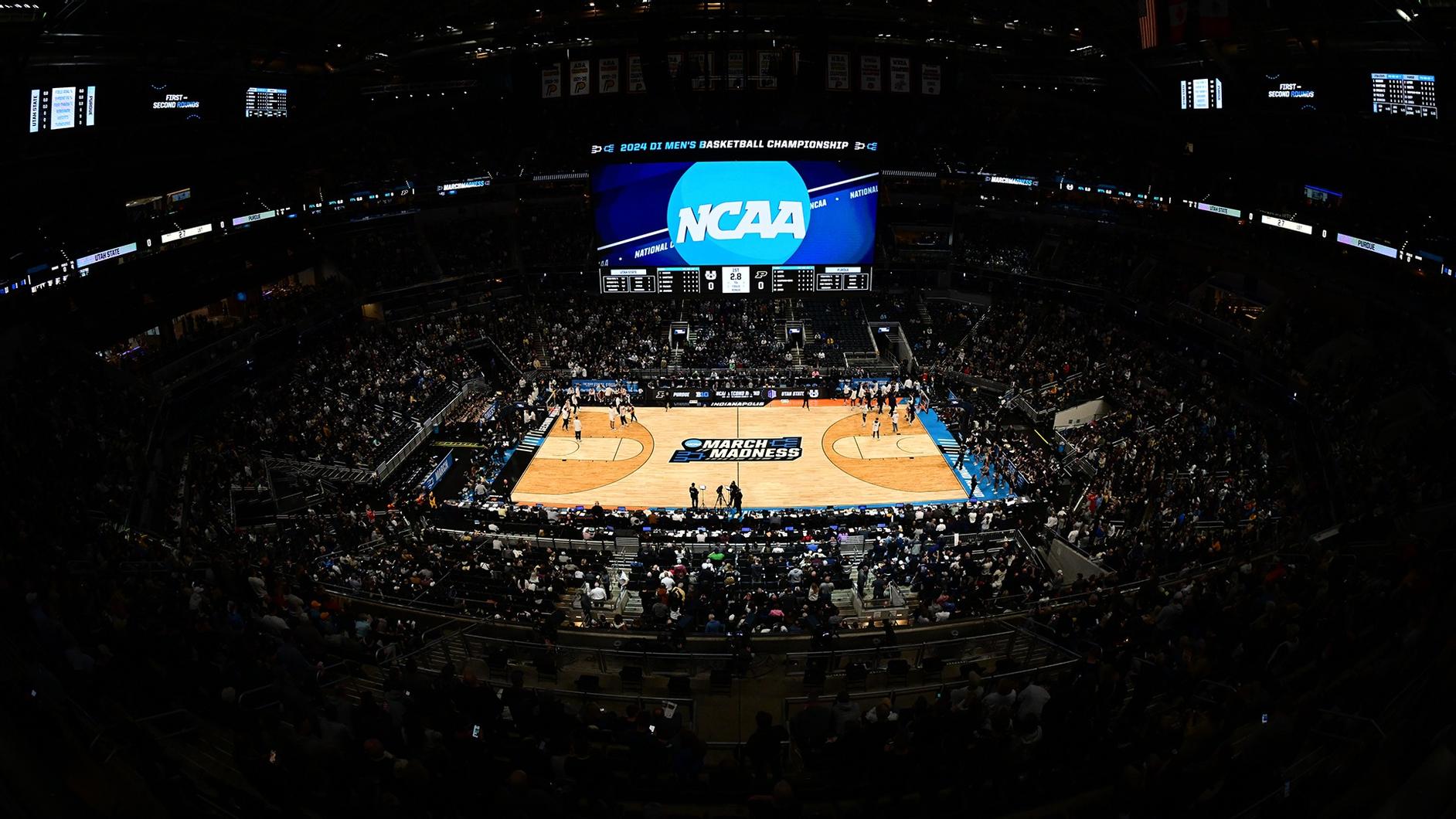Inside mediahouse
Technology has revolutionized the way news and current affairs are presented on television. Viewers have been enthralled by up-to-the-minute relay of news items, and the ability to deliver breaking stories quickly has often taken precedence over picture quality and the stability of the transmission link being used.

The main audio dubbing suite employs an AMS Neve DFC desk and 5-meter video projection screen.
This article will take a look at some of the digital technology advances that have either improved existing news gathering systems or opened up the possibility of using completely new techniques. Satellite news gathering (SNG) and electronic news gathering (ENG) will be considered by examining the current market, and exploring what innovations will change the technology approach to give broadcasters the winning edge.
SNG
Innovation and standardization of video compression and digital modulation schemes have improved and simplified satellite news gathering. (See Figure 1.) Compression manufacturers have widened the capability of their equipment by offering enhanced RF capability, adding increased functionality and improving the performance of their video encoders.
On the RF side, a few manufacturers offer internal upconversion to L-band. In addition to reducing the size and cost of a system, this move simplifies control because it allows fixed frequency block upconverters to be used, overcoming the need for costly external frequency agile upconverters. Increasingly, broadcasters desire telephony and remote LAN capability to be offered alongside video and audio from OB locations. By providing the necessary phone, data and IP connectivity, these services can be transmitted alongside the video and audio uplink as private data packets within the MPEG transport stream. This is a particularly efficient way to provide communications and data provision because it does not suffer from the large, variable delay incurred by rival, bandwidth-hungry IP-based systems.

Mediahouse uses the Pharos Pilot MCR system to control its Quartz routers and a wide range of ancillary equipment, including Axon Digital Design Synapse synchronizers, aspect ratio converters, SDI audio shufflers and general interfaces, Eyeheight line-identifiers, satellite dish positioners and receivers.
Get the TV Tech Newsletter
The professional video industry's #1 source for news, trends and product and tech information. Sign up below.
Video compression has improved markedly since the first MPEG-2 encoders were developed. The reduction in bit rate to maintain broadcast-quality pictures not only benefits broadcasters in terms of the reduced satellite segment space required, but also allows smaller dishes and low-power amplifiers to be deployed in OB systems.
While providing impressive capability and offering a truly mobile news bureau out in the field, the system is still bulky and needs skilled personnel to set up and operate. More compact systems have been developed, but these compromise picture quality and suffer from poor transmission reliability.
Videophone
Videophone news footage has become commonplace on our screens. The challenge for broadcasters is to improve the picture and service quality as well as improve the ease of operation and system latency. Achieving this goal is not just a hardware issue. Standards for both video compression and modulation schemes oriented towards low bit-rate operation are required. Additionally, new satellite and fixed infrastructure is required for a closer match between the bit rates required for broadcast-quality pictures and that available from a satellite or fixed link.
Windows Media 9 and MPEG-4
New advanced video compression standards, such as Windows Media 9 and MPEG-4 part 10, are emerging that offer the promise of significant performance improvements over existing MPEG-2 systems. While broadcasters will welcome the reduction in bit rate, there are still a number of system issues to address before these compression standards are appropriate for the majority of SNG or ENG networks. These include latency, availability of professional receivers and, in the case of MPEG-4, licensing terms. It looks certain, however, that in the long-term such technologies will find a place in news networks.

Shown here is one of two studio galleries. Each gallery is equipped with a Sony DVS-7200 series vision mixer, a couple of Sony Digital Betacam VTRs and an EVS Live Slow-Motion server.
DVB-S2
The new DVB-S2 modulation standard offers improved error correction, more robust and efficient modulation modes, and return channel capability. Overcoming the inertia behind existing schemes will be one challenge this new standard faces. The first systems to endorse DVB-S2 are likely to be high bit-rate applications such as data carriage or HD, where new infrastructure is required.
As well as the emphasis on improving low data rate performance, broadcasters also are looking to expand the number of channels that are provided by a contribution link. This has led to existing satellite systems being extended to offer program multiplexing and relay over fixed transmission links instead of just over satellite.
ENG
For local and city-wide news gathering using microwave or ENG systems, the long-promised digital revolution is finally happening. Although the benefits of COFDM-based systems are well-known and accepted by the industry, delays in worldwide spectrum re-allocation legislation have meant a slow adoption of the new technologies. This, however, has given manufacturers the opportunity to further develop their products, resulting in smaller and lighter transmit units and advanced techniques such as diversity reception, which will revolutionize the design and operation of ENG systems.
FFT maximum ratio
combining diversity
Multichannel diversity reception is now a reality and eliminates the need for antenna switching and steerable dishes at central receive sites. FFT maximum ratio combining is technically the most complex diversity method, but also very effective.

For linear editing, Mediahouse employs a Sony BVE-9100 editor, Sony DVS-7200 vision switcher, Sony DVS-2000 vision switcher, Sony DME-7000 for video effects, Sony DMX-E3000 audio mixer and Quartz 32x32 SDI router.
Channel equalization is key in an FFT diversity receiver, where pilot carriers and other information are used to assess the condition of each of the individual 2k carriers. These are allocated a mathematical confidence value relating to the level of perceived degradation and the confidence that the data within the carrier is correct. A diversity algorithm then assesses the separate confidence values returned for each input and carrier, and can then decide the ratio at which each of the inputs is combined, on a per-carrier basis. This makes it possible to reconstruct each carrier to provide the best possible signal for demodulation, and then error correction, by the subsequent Viterbi and Reed Solomon stages. (See Figure 2.)
FFT maximum ratio combining is able to out-perform other types of diversity switching because it is possible to use the output of any antenna in part or full combination to reconstruct a damaged signal. This technique can be used to implement an effective fully-automatic diversity system, as there is no hard switching between inputs, either at the RF or MPEG packet layer, thus allowing clean and progressive transitions to occur between antennas.
Multichannel diversity reception
In practice, multiway diversity overcomes the problems of designing high-gain omni-directional antenna systems. By using diversity reception, a central receive site can be equipped with a number of high-gain flat-plate antennas, typically 18dBi, arranged to give 360-degree coverage — similar in concept to a mobile radio base station antenna array. The multiway diversity receiver will sample the signal from all antennas and, by using the FFT process, combine the signals from all antennas to produce the best possible received signal.
Extensive field trials in live ENG environments have proven that ENG trucks and helicopters can move around or be at any static transmit location within range of the central receive site, and the completely automatic diversity process will select the correct antennas without operator intervention.
Multiway diversity reception simplifies central receive site operation. When combined with simple transmit equipment using a flat-plate antenna with a beam width of 30+ degrees, it allows a complete system to be designed that requires no technical operator involvement to deliver live news.
The future
We have taken a glimpse of the new technology developments that are being delivered today. The growth of HDTV is also driving a consumer desire for HD news and live event coverage. HD solutions for SNG have already been developed. Whether for ENG or SNG, all of these developments share a common goal — to enable OB and news gathering teams to get the story as it happens, and deliver the best pictures of live events. It is this need to be on top of the story that will continue to drive the development of systems that are rapid to deploy and easy to use in the field.
Noel Matthews is the business development director and Ian Trow is the mobile segment and product manager for TANDBERG Television.
broadcast
